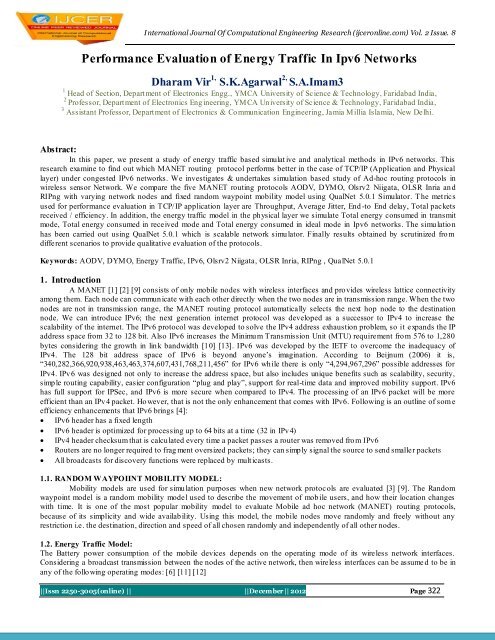ISSN: 2250-3005 - ijcer
ISSN: 2250-3005 - ijcer
ISSN: 2250-3005 - ijcer
Create successful ePaper yourself
Turn your PDF publications into a flip-book with our unique Google optimized e-Paper software.
International Journal Of Computational Engineering Research (<strong>ijcer</strong>online.com) Vol. 2 Issue. 8Performance Evaluation of Energy Traffic In Ipv6 NetworksDharam Vir 1, S.K.Agarwal 2, S.A.Imam31 Head of Section, Department of Electronics Engg., YMCA University of Science & Technology, Faridabad India,2Professor, Department of Electronics Eng ineering, YMCA University of Science & Technology, Faridabad India,3 Assistant Professor, Department of Electronics & Communication Engineering, Jamia Millia Islamia, New Delhi.Abstract:In this paper, we present a study of energy traffic based simulat ive and analytical methods in IPv6 networks. Thisresearch examine to find out which MANET routing protocol performs better in the case of TCP/IP (Application and Physicallayer) under congested IPv6 networks. We investigates & undertakes simulation based study of Ad-hoc routing protocols inwireless sensor Network. We compare the five MANET routing protocols AODV, DYMO, Olsrv2 Niigata, OLSR Inria andRIPng with varying network nodes and fixed random waypoint mobility model using QualNet 5.0.1 Simulator. T he metricsused for performance evaluation in TCP/IP application layer are Throughput, Average Jitter, End -to End delay, Total packetsreceived / efficiency. In addition, the energy traffic model in the physical layer we simulate Total energy consumed in transmitmode, Total energy consumed in received mode and Total energy consumed in ideal mode in Ipv6 networks. The simulationhas been carried out using QualNet 5.0.1 which is scalable network simulator. Finally results obtained by scrutinized fromdifferent scenarios to provide qualitative evaluation of the protocols.Keywords: AODV, DYMO, Energy Traffic, IPv6, Olsrv2 Niigata, OLSR Inria, RIPng , QualNet 5.0.11. IntroductionA MANET [1] [2] [9] consists of only mobile nodes with wireless interfaces and provides wireless lattice connectivityamong them. Each node can communicate with each other directly when the two nodes are in transmission range. When the twonodes are not in transmission range, the MANET routing protocol automatically selects the next hop node to the destinationnode. We can introduce IPv6; the next generation internet protocol was developed as a successor to IPv4 to increase thescalability of the internet. The IPv6 protocol was developed to solve the IPv4 address exhaustion problem, so it expands the IPaddress space from 32 to 128 bit. Also IPv6 increases the Minimum Transmission Unit (MTU) requirement from 576 to 1,280bytes considering the growth in link bandwidth [10] [13]. IPv6 was developed by the IETF to overcome the inadequacy ofIPv4. The 128 bit address space of IPv6 is beyond anyone’s imagination. According to Beijnum (2006) it is,“340,282,366,920,938,463,463,374,607,431,768,211,456” for IPv6 while there is only “4,294,967,296” possible addresses forIPv4. IPv6 was designed not only to increase the address space, but also includes unique benefits such as scalability, security,simple routing capability, easier configuration “plug and play”, support for real-time data and improved mobility support. IPv6has full support for IPSec, and IPv6 is more secure when compared to IPv4. The processing of an IPv6 packet will be moreefficient than an IPv4 packet. However, that is not the only enhancement that comes with IPv6. Following is an outline of som eefficiency enhancements that IPv6 brings [4]: IPv6 header has a fixed length IPv6 header is optimized for processing up to 64 bits at a time (32 in IPv4) IPv4 header checksum that is calculated every time a packet passes a router was removed from IPv6 Routers are no longer required to frag ment oversized packets; they can simply signal the source to send smaller packets All broadcasts for discovery functions were replaced by multicasts.1.1. RANDOM WAYPOIINT MOBILITY MODEL:Mobility models are used for simulation purposes when new network protocols are evaluated [3] [9]. The Randomwaypoint model is a random mobility model used to describe the movement of mobile users, and how their location changeswith time. It is one of the most popular mobility model to evaluate Mobile ad hoc network (MANET) routing protocols,because of its simplicity and wide availability. Using this model, the mobile nodes move randomly and freely without anyrestriction i.e. the destination, direction and speed of all chosen randomly and independently of all other nodes.1.2. Energy Traffic Model:The Battery power consumption of the mobile devices depends on the operating mode of its wireless network interfaces.Considering a broadcast transmission between the nodes of the active network, then wireless interfaces can be assume d to be inany of the following operating modes: [6] [11] [12]||Issn <strong>2250</strong>-<strong>3005</strong>(online) || ||December|| 2012 Page 322
















